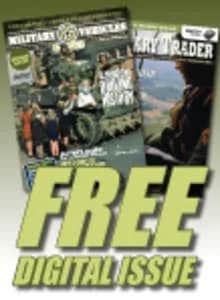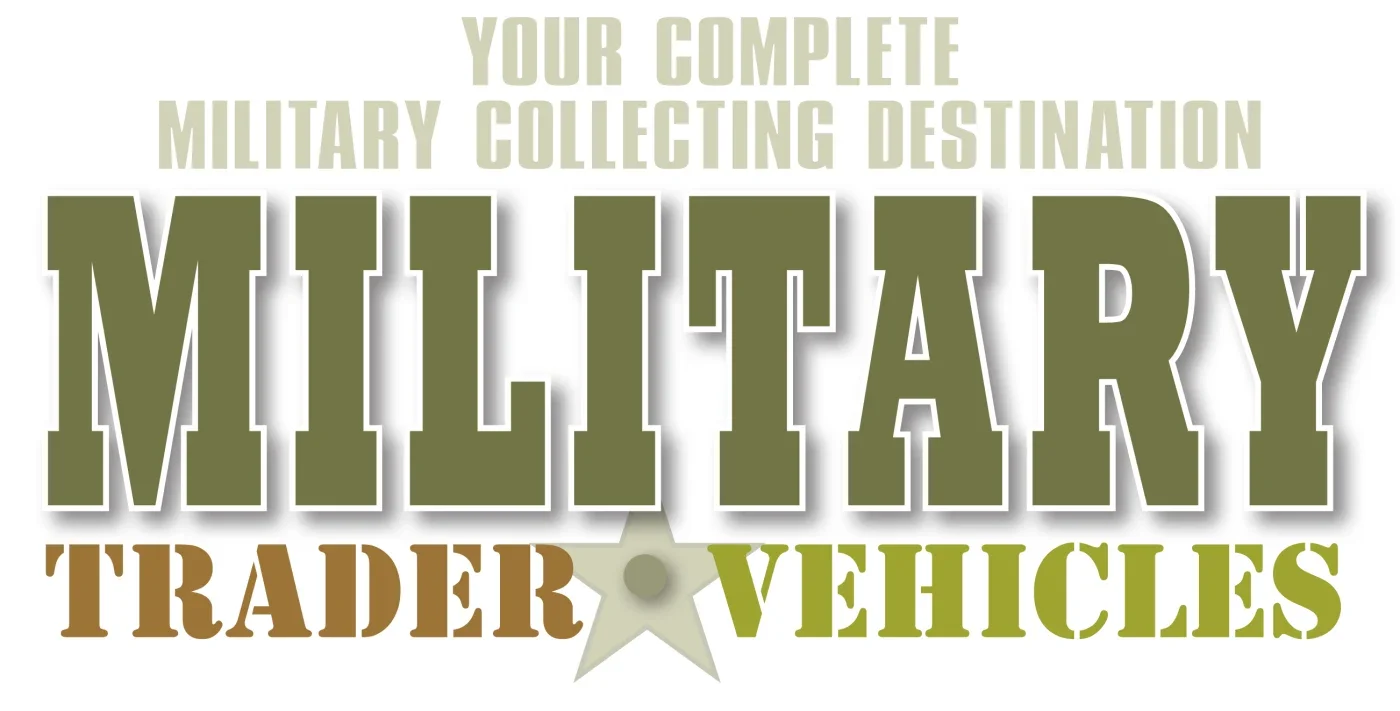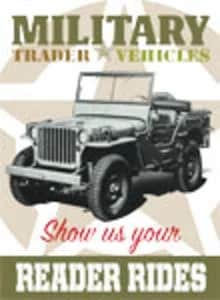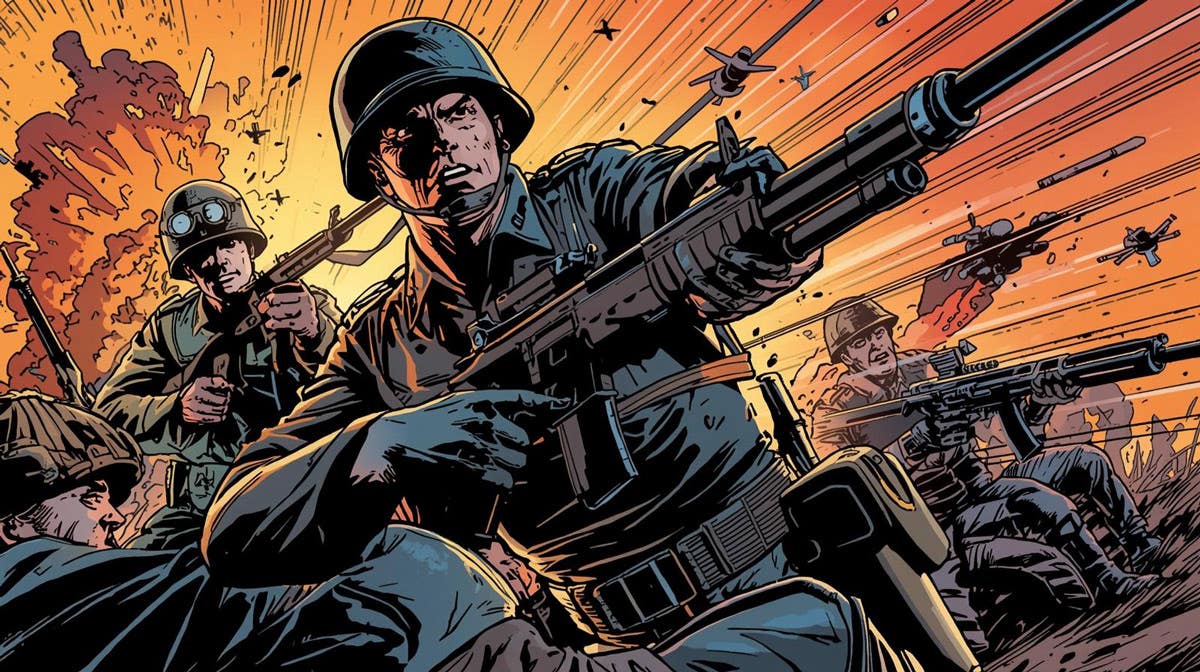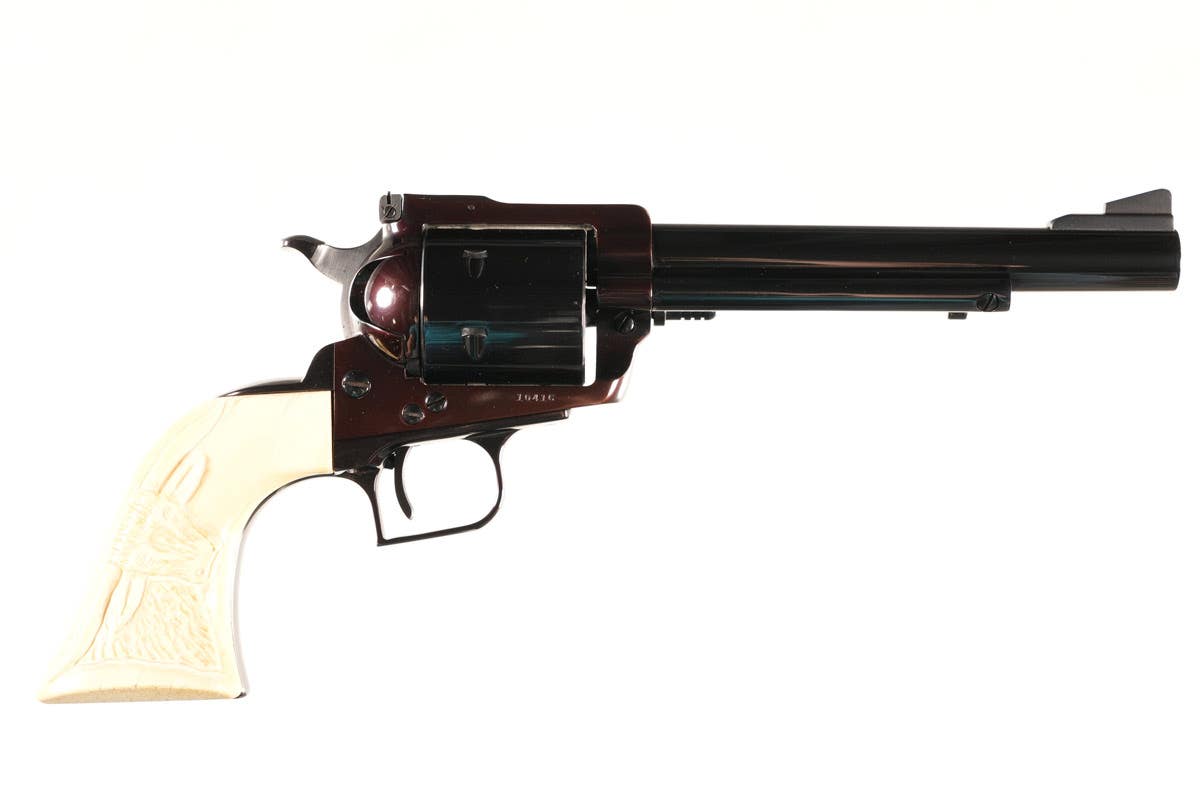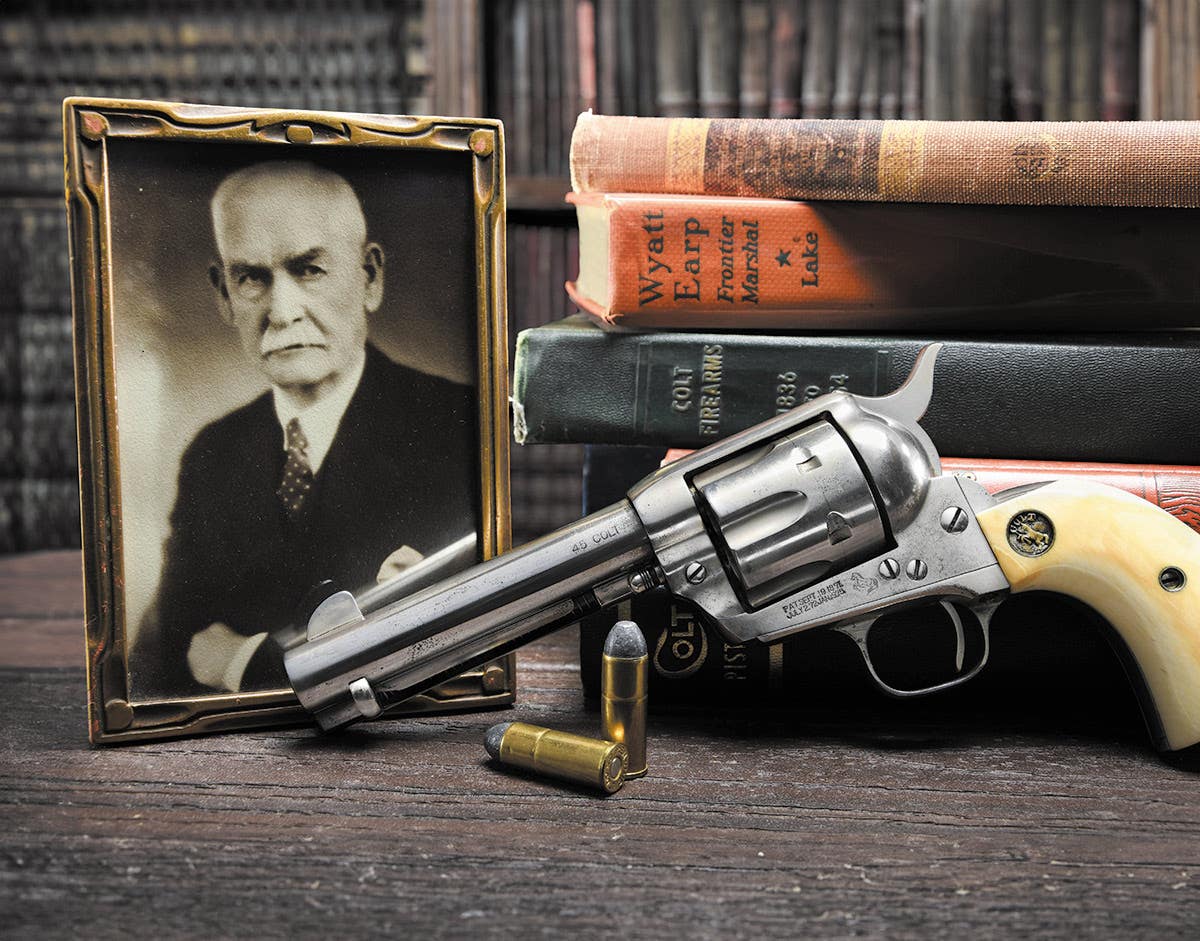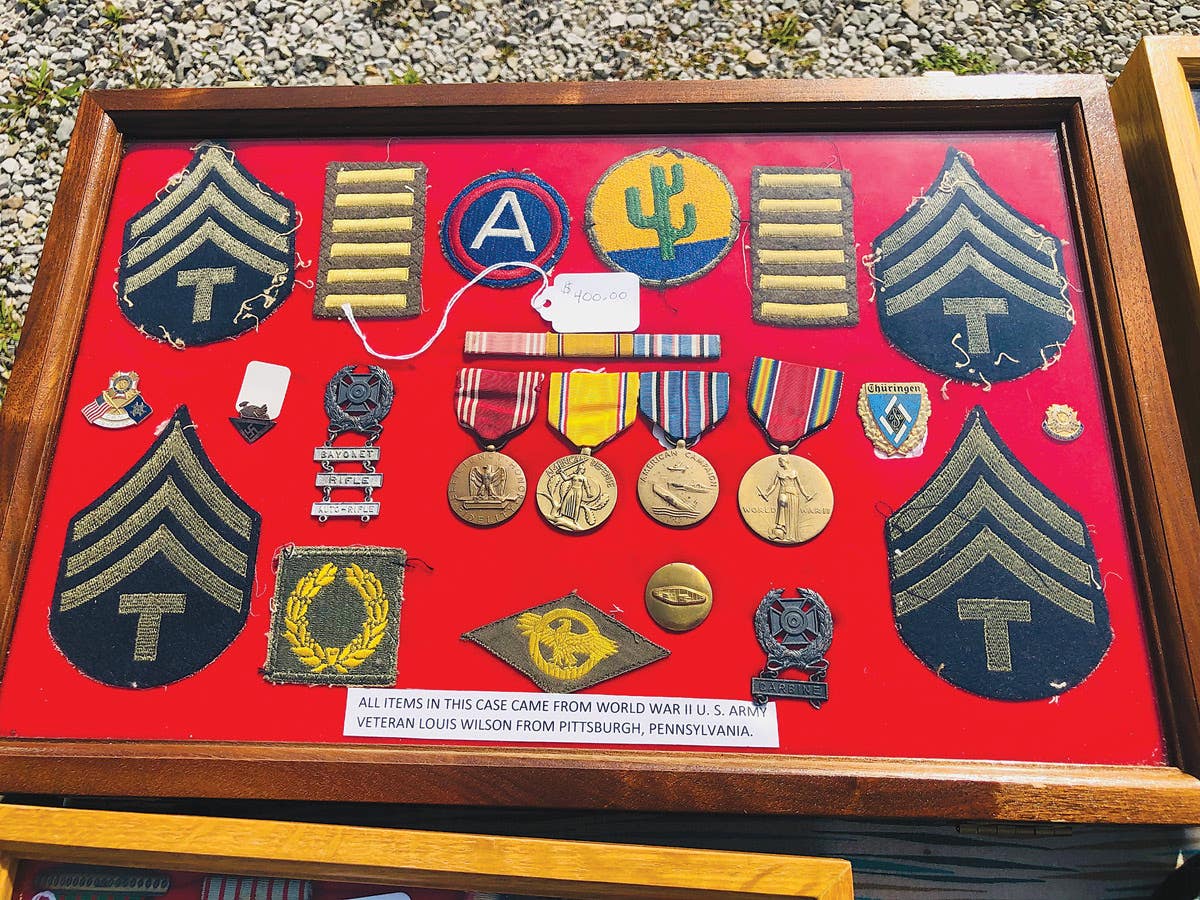10 Questions: With Mr. Jerry and Mark of Military Collectibles Shop
We are all in this together. In an effort to report on the state of different facets of the military collectibles market, Military Trader strives to discover and share the…
We are all in this together. In an effort to report on the state of different facets of the military collectibles market, Military Trader strives to discover and share the opinions of the hobby’s leading dealers and collectors. This month, we had the privilege to talk with Mr. Jerry and Mark of Military Collectibles Shop. Most will recognize the names as those of the longtime professional, full-time dealers and owners of The Military Collectible Shop in West Allis, Wisconsin.
Jerry is the smart partner. Jerry has been collecting military items since he was 9 years old when he first discovered an attic box of U.S. divisional patches leftover from his grandfather’s collecting days. Jerry now focuses mainly on WWII European theatre items. His special interest is in Waffen-SS items, Afrikakorps, Panzer, Grossdeutschland, and any Normandy-related items.
In the U.S. realm he collects Airborne, Tanker, Tank Destroyer, Mountain troops, Army Air Corps, Ranger, and again, anything Normandy-related. He also has a soft spot for military flags and unit-painted US helmets. He also has an extensive woman’s military uniform collection and WWII vocational school fighting knives made in Wisconsin.
Jerry is currently writing a photographic reference book on the homefront flags of WWI and WWII. He has been selling since 1997 on e-bay as “Mr.Jerry.”
Mark is the good-looking partner. He sometimes wears a pirate hat and says “Arghh.” Mark’s father was a Sergeant Major in the Wisconsin National Guard, which spurred his interest in military items. Mark started building military models and collecting US patches in the 1960’s. He became interested in German items and bought his first Iron Cross when he was 13 years old.
Over the many, many years Mark has been on this planet, he has collected a wide variety of US, German, Italian, and Japanese WWII militaria. His collection includes patches, pins, medals, flags, field gear, firearms and edged weapons. He has since sold off most of his firearms and is now focusing on a wide range of German award badges and medals.
The pair has been in business since 1995 under the name Historic Militaria Service. In 2001, they opened their Milwaukee area store, “The Military Collectibles Shop,” where they provide their world-wide customers with quality military collectibles and books. With many years experience in operating a storefront, Mr. Jerry and Mark have a very good sense of the ups and downs of a traditional storefront. We are pleased to offer his response to our “10 Questions on Operating a Militaria Shop”
Military Trader: Thanks so much for taking the time to meet with us. I realize that you are “guys of all trades” having your hand in all facets of militaria, but your store seems to be the center of it all. Tell us how you decided to open a store for military collectors
Jerry: I had been selling militaria at shows since 1995. Being collectors from Milwaukee, Mark and I both used to hang out as much as we could in Bill “Scotty” Scott’s Military Relics Shop. When he closed his shop, we found that we had no place to go.
The inspiration for opening my own shop actually came to me while I was on vacation in Switzerland. We were driving through this small Swiss “cow town” (literally, cows walking in the streets) and we passed a brick building with a WWII German Panzerfaust hanging in the window. I yelled, “Stop the car!” Approaching to see what it was, I discovered it was a military shop. (The sign said they were only open on Wednesdays. Of course, we were there on Thursday.)
I had thought, “Hey, I could do that. I could be open one day a week!” So that got the ball rolling. We decided to try it for a year and see – and that was 13 years ago!
It turns out that we decided we would be open nights and weekends—what we call, “working collectors hours.” We remembered how it was always difficult for us to get away from work to get down to Scotty’s shop. It turns out that people do find us, even with our odd (but regular) hours.
Military Trader: The way people collect has changed dramatically since you opened the Military Collectibles Shop in 2001. How has your typical customer changed over those years?
Jerry: We have a really wide range of collectors that shop with us. We have a few that look for very specific high dollar things. On the other end of the spectrum, we have button, DI, and patch collectors and many mid-level collectors that look for medal groups We still have a few upper level buyers, but I think we really try to find our niche in the mid-level range of affordable quality military items.
People have also gotten very specific in what they collect. When I started, one guy did WWI and other guy did AAF, and you could pretty much sell them anything that fit into that broad category.
Now, people are collecting German badges by maker, German helmets by size, US field gear by date, etc. I think by being specific, it gives them a way to best utilize their available resources. (and they won’t end up having to open as store because they have too much stuff to fit in their house like me).
Over the years, I have seen many people drift in and out of the hobby. Some change gears by going from Civil War to WWII or some shift away from German into WWII US because of the prices and reproduction problems. WWI is on the rise as well as it is still widely available.
Before the crash of 2008, people had more disposable income. Some collectors would spend $100-300 a month on US patches. After the crash, those guys were still buying, but it dropped down to $20-40 a month.
These days, people are still cautious with their money. Common things are moving slower, so you have to price things very competitively. The higher ended or unique items are still in demand and go quickly.
One area that has really taken off are “named items.” It used to just be the named medal groupings, but now anything you can put the history too is really sought after. Collectors are really appreciating the actual history of the items now.
One other thing that has changed for us is that we are now dealing with much more educated and informed sellers. There have been times when someone will bring in something like a .45-70 Springfield rifle, and I would be like “oh cool, a Trapdoor rifle.” Then the little old lady rattles off all of this information she had gotten off the internet on production numbers, sight variants, inspector marks, years produced, and documentation of every sale in the past 10 years.
But that also has an upside. When you are straight-up with people, and you tell them the truth and it turns out that you validate what they already know, they are usually more willing to work with you.
Another thing that has actually helped us are the “American Pickers / Pawn Stars” type of TV shows. They have helped to get people to understand a bit about the business. Even though this is a hobby we love, we are in business and need to make a bit of a profit on what we buy to sell.
We really try to stock a variety of items at our shop and at shows, from our $1 box, to the high dollar items. That way, we are able to appeal to a wider range of customers. We always try to work with people. We know how it is. We are collectors too!
Mark: The young, beginning collectors seem to be better informed and decide on what they want ahead of time. When they come to the shop, they focus on what they want and not what we have.
I’m impressed when an 8-year old comes into the shop with his father and dad says, “Look Kyle they have a bazooka” and Kyle looks at dad and says, “No Dad, that is a Panzershreck.” Then dad says,” Look! They have an MG-42,” and Kyle looks at Dad and says, “No, Dad. That is an MG-34. Do you guys have any egg grenades?”
I see items like captured Zazi flags that where autographed by the GIs have gone up in value. Those flags used to be hard to sell and often sold cheaper since collectors preferred un-altered examples. Now that there are far fewer WWII vets around, those flags seem to honor those soldiers. The increase in prices reflects that. Even US field gear and helmets with the GIs names seem to be hot sellers.
I see young collectors focusing on WWII and have little interest in the other wars. Rarely do we see any collector under 50 who collects Civil War items.
Military Trader: The Internet is blamed for the closing of many traditional storefronts. But through it all, the Military Collectibles Shop has remained open. How have you maintained your business through the introduction and nearly total takeover of the Internet into our hobby?
Jerry: When we first opened up the shop, eBay still allowed the sale of Third Reich items. That was really the “happy time” for both buying and selling. But then six months in, they prohibited those items being sold, and things changed dramatically. That did impact our business, both for good and bad.
But overall, we have embraced the power of the Internet. You have to be much more active now in finding and tracking down things, and then finding customers for them these days. It is not like the old days when veterans were lined up with shoeboxes full of relics at your doorstep.
Now, we are able to buy things from people all over the country because of the Internet. We can email photos and videos and even video conference with potential customers.
I think the fact that we do have a physical storefront presence does give us some tangible credibility and that is important when people are shopping things around to sell. That kind of credibility is important when people buy from us too. They know that we are not a fly-by-night operation.
In terms of researching some of the historical artifacts we acquire, the Internet is invaluable. By being able to add a bit of history to a named artifact, we are now able tell a story that was long-forgotten. We have even found photos of the veterans to keep with the items.
We are active in the social media venues and use those channels to help celebrate the hobby and get people talking. We have embraced the various on-line forums to help ourselves continue to learn things and to share what we know with other collectors. I also serve as a forum moderator on the USmilitariaforum.com and Germandaggers.com.
There is still a huge benefit of being able to see and touch something, and to get a chance to see something that you might not have looked for out on the net. That Civil War sword may just speak to you as a collector in the shop, but unless you specifically search for one on the net, you may not have run across one to know you even wanted one.
Mark: Sometimes, while I’m sitting in the shop surrounded by all of the military items, I think to myself, “Man does this place look over-loaded!” And then, some people come in for the first time and say “Oh my gosh! this place is great!” Then, I think to myself, that if I came into another store like ours I probably would hang out there for hours.
People like to hold things in their hands. They like to feel how heavy things are. Sure, you can look up nearly anything on the Internet, but that does not compare with seeing it in person.
The sellers are much more at ease meeting us at the shop then having to meet us at their home or somewhere else. And, a lot of people are afraid of selling on the Internet. However, they don’t seem to be afraid of looking up their items and telling us what they are selling for! Sometimes, we have to explain the difference between what items are “selling for” and what people are just “asking for” them on the internet.
Several years ago, I bought two large-sized US Army officers tunics for a captain who was a dentist in the Army after WWII. Both tunics were dated 1947, and I felt that there were worth about $75 each with the insignia on them. I sold the first one for $850 on eBay, the second one sold the next week for $75. To me, someone paid a lot of money for a $75 uniform. But now, other people see that and think, ”Oh, they must be worth $850!” Unfortunately, an“auction fever” anomaly can become a reference point.
Military Trader: Through all these years, what methods have you used to maintain customer traffic to the store?
Jerry: We try to maintain a very welcoming and interesting environment, especially for new and younger customers. We encourage discussion on artifacts, history, etc. We also really encourage questions.
There is a group of regular customers that comes by each week. They are always eager to share their knowledge. Plus, on some Saturdays, we serve free hot dogs.
Advertising in Military Trader has been a great help to get word out about the website and has had the added benefit of getting people into the store who may have not known we are there. I also like to keep changing our front window displays. I know, as a kid, I was always drawn to the cool window displays at the local Army/Navy stores.
We also realize how important it is these days to fully guarantee everything we sell. Bill Scott was an excellent role model for us in running a business: “Be honest, stand behind what you sell, always maintain your morals no matter what it costs you in dollars, and don’t take any #@$# from anyone.”
Mark: We always try to be engaging with our customers. If someone brings in something to sell, I tell them what it is, and what it was used for. If they are selling something that Grandpa brought back, I ask them about Grandpa and whatever they can tell me about his military service.
One lady told me her father told everyone he took the samurai sword he brought home from WWII he had take from a Japanese officer who he had killed. A couple of weeks before her father died, he told her that he had not killed the Japanese officer, and he picked the sword out of a pile of them after the war!
We always treat people fairly. As a result, we get a lot of word-of-mouth referrals. We always stand behind our “Guaranteed to be original” policy.
Military Trader: You have also had your hand in show promotion. What sorts of things have your tried with your own show that you consider particularly successful in broadening your customer base?
Jerry: We are actually not doing show promotion, but are very active supporters of Neil Johnson and Craig Luther’s Military Hobbyist Show in Oak Creek, Wisc., the Badger Military Show in Waukesha, Wisc., as well as the Military History Fest and the Rockford, Illinois WWII Days event. We participate in all of those.
We believe, for the hobby to survive, we all need to work together to share our passion with more people. Integrate the hobbies, get the collectors and re-enactors, vehicle guys and modelers together – they all are potential customers and resources for items.
Military Trader: Now the $100 dollar question: How do you do it? I mean, we all dream of owning a shop and sitting around waiting for that Hermann Goering sword to walk in the door. But that isn’t realistic. You have raised families while maintaining a storefront and promoting and / or attending shows. What is the key to keeping a business like this alive, let alone, profitable?
Jerry: I won’t lie, it is a lot of hard work and a huge time commitment. There is no sitting around, we have to keep on going, and there is always something that needs to be done. Plus, what many people don’t realize is that Mark and I each work regular 40+ hour jobs (And I am an adjunct college instructor on top of that). But that supports our family lives. The shop is self-supporting (usually).
My wonderful wife Shari really helps out, too, she does all of our website and eBay listings, shipping, and our bookkeeping. Most people don’t realize they are dealing with Mrs. Jerry. She actually puts in more hours than Mark or me!
Everyone sees the good times like when that full footlocker or rare helmet comes in. But no one is ever around when we have to clean the bathroom, meet the fire inspector, or are loading in after a buying a collection after driving 400 miles—at night and in the rain—only to have to get up at 5:30AM and go to work. It’s not always as glamorous as it looks.
But, it has been a huge amount of fun and very rewarding, I have acquired some great items for my own collection, and I get to make many other collectors happy by finding great stuff for them. It’s kind of like being Santa Claus and being paid to do it.
I have been able to meet and talk with many great veterans and other collectors. Those kinds of experiences make all of the hard work worthwhile.
One of the areas we are currently looking to expand into is the on-line auction arena. With the success of our website, we have realized that there is still a gap in finding customers for some of our more unique historical items, as well as the “You can’t sell it on eBay” kinds of items like US valor awards and certain weaponry that are just hard to price.
Having our own auction venue will allow us to expand our customer base and take on consignment items from people that aren’t comfortable selling outright. Look for more to come on that as we move forward in future issues of Military Trader!
Mark: In this business, you have to love what you are doing . It becomes a lot easier if you do. The key issue is to stick with it. We have limited hours at our shop since both of us work full time jobs. We are rarely close during those scheduled times and are rarely late. We do schedule to meet up with people on occasion. If a large collection is involved, we prefer to make appointments.
Always be honest and fair. I hate when I hear how someone talked some widow out of her late husband’s named Purple Heart by telling her it was going into a museum, and then paying her only $20 for it—just to resell it to a collector for $600.
We are collectors, and as such, we have paid a lot money for items that turned out to be fakes. These are our lessons. We do not attempt to pass them off as original to others.
I love to talk to new people in the shop. I show them stuff that I feel is interesting. There are a lot of stories that came in with the stuff we have purchased over the years, and it is great to share them with the customers. We have also met a lot of great people. We try to keep their stories alive.
Military Trader: Operating a partnership must have its pitfalls. What insight can you share about collectors who go into business together?
Jerry: Just like with any other relationship, trust is the first and foremost thing. Honesty and communication are right up there, too.
Mark is like a brother to me. In fact, we have so much in common that many people think we are related.
Having a clear plan of expectations is also important. I collect certain things, and Mark collects certain things, so we each have our “dibs” system already in place. It is better to talk about those kind of things ahead of time than to have hard feelings later on.
When people come in to sell us things, we each grab a calculator and tabulate what we think we should pay. It really helps to have that second set of eyes to see a cracked handle, missing pin, or if there is something outside of our own realm of knowledge that the other one knows more about. For example, Mark knows more about guns and badges than I do, while I am better at cloth insignia and everything else. But we are usually within 10% of each other with our numbers. Sometimes, it’s spook!.
Mark: I have seen many bad partnerships. Distrust and back-stabbing is something that most people don’t see coming. Communication and trust is all important. Jerry and I communicate with each other nearly every day. We have complete trust in one and other.
We are both collectors and we make personal purchases. If Jerry picks up something stellar for his collection at the shop, I think it is great and tell him so. Jerry is the same way. There is no jealousy. If I’m working on something for my collection, and it comes in on a day that Jerry is working, there is no problem there. We each have our own separate field in collecting, so we don’t step on each other’s toes. If you don’t collect anything, then the business is just a job.
We work with each other for days off. If one of us can’t make it in, the other will switch days with him. We both enjoy the hobby and working the shop. We work together on Saturdays and usually have a lot of fun while we are there.
Military Trader: Many might not see the worlds of collecting and reenacting not coexisting in harmony, and yet, you embrace these two facets of the hobby. What insights about re-enactors can you share with traditional militaria collectors?
Jerry: They certainly are two different worlds, but there is a lot of overlap. At the core, both camps share a deep love of history. And both also share a love of good field gear… But overall, and I mean this in the nicest way, re-enactors are generally um, very frugal. Most are willing to trade items, however, which is always fun.
We sell a lot of our mid- and lower-level items at re-enactments. They are not quite as picky on condition. The re-enactments are good outlets for reproduction items that we sell (as such).
Re-enactment events are a really great time. There are many great displays of combat items, and there is something about hearing a tank or cavalry charge thunder across a field and seeing much of the stuff we collect in action.
Plus, doing these events gets our original items in front of a new audience who may have not ever thought about collecting. Also, there are many more pretty girls that show up at reenactment events than you will ever find at a military show.
Mark: I think re-enactment events are a great way to get people interested in the hobby. It helps being the past alive without the bad part. I enjoy the events and especially the re-enactors who explain the different equipment used.
When you look inside of a Sherman tank and see how cramped it is, you appreciate the tanker whose grouping you own. But certainly, most of the re-enactors with whom I deal with usually only collect a few original items. They are often less concerned about fakes or condition.
I know the re-enactors do occasionally get flak from vets. We know of one guy that grills re-enactors: “What gives you the right to wear that 101st uniform? Were you ever in the service?” I don’t think some 18-year-old is trying to steal someone’s valor or make light of a group old WWII vets any more than I do when I dress like a pirate. “Arghhhh!”
Military Trader: Our readers love stories about collectors’ “Favorite Finds.” Tell us about what you consider one of your favorite store “walk-ins?”
Jerry: One of my favorite pieces is a WWII US medic’s painted helmet with a Hawley liner that also has the red crosses on it. Both have a bullet hole through the top and a camouflage net still hanging on it. I was literally shaking when I pulled that out of the guy’s bag of stuff. It belonged to the guys brother. He survived the head shot while serving with the 91st in Italy. He had been awarded the Silver Star.
I also have a very complete US P-47 pilot grouping. I was fortunate enough to meet with the pilot on a few occasions before he passed away.
I also have George Webb’s WWI dog tag. After the War, he became a locally famous Wisconsin hamburger restaurant chain owner and name sake. That’s just kind of a fun thing for people here to see.
Thinking about it, I have really been fortunate in what we have had come in the shop. My only regret is that early on, I did not do more documentation of the veterans and their stories. Talk to those guys and gals while you still can!
Mark: One of my favorite walk-ins was when a guy brought in some SS Soldbücher and an anti-guerrilla warfare badge in gold. His uncle was a MP in Germany right after the war. Since Jerry is the SS collector, he ended up with the books, and I have the badge.
Several years ago, a young woman brought in an engraved German Army officer’s dagger in excellent condition. She said she inherited from her grandfather. I made a fair offer on it and she left. About two years later, she came back and accepted our offer. We have the dagger for sale now on our website.
I did get a Herman Goring division tunic that walked into the shop. I have that in my collection.
The strangest item to come in was a small Native American amulet. The collector had found it while on a dig in Wisconsin. The image looks like a face of someone screaming. He told me it was the first Indian to see a dinosaur. I thought that was pretty funny and bought it.
Military Trader: And finally, share your opinion on how whether a militaria shop can be successful if it opened for business today.
Jerry: I think it can be successful, but it is tough. There are more local rules and regulations in place than ever before. We get lumped in with pawn shops on how we are regulated, so have to really play by the rules.
We could not open the same shop in the same area we are in because of new city regulations. We have to hold items for up to several weeks before we can sell them. We have to electronically report what we buy. That can be tough when you buy a collection and now you have several thousand dollars that you can’t even start to think about selling for almost a month. But that is the cost of doing business.
Today, it important to be diversified. Try to have a little something for everyone. We carry a wide variety of items, from uniforms and helmets, to books and artwork, and even toy soldiers for the kids.
Also build on the hobby. We really try to encourage new collectors by sharing our knowledge with them and letting some borrow reference books.
Take advantage of all that social media offers you in ways to connect with your clients and future customers.
Above all have fun. Do this for the right reasons. It’s not about the money, it’s about the history and honoring those who served.
Mark: I think if you want to open at shop, you need to have compassion and respect for the people who are bringing in their family members’ military items. You can’t treat one person better just because her father was a WWII Marine and tell another lady that her late husband’s Class A uniform is not interesting because he didn’t go to war.
You can’t expect to immediately have a thriving business. It takes a while to gain people’s trust.
And finally, a lot of your time will be tied to the store. Make sure your wife understands that.
We are honored to interview and report on prominent players in our hobby. To learn more about Jerry and Mark’s business, the Military Collectibles Shop, or more importantly, to view their current offerings, log onto www.miltarycollectorsHQ.com. If you would like to visit Military Collectibles Shop showroom, it is located at 9106 W. Greenfield Ave., West Allis, WI 53214. It is open, 6pm-8pm, Monday-Thursday, and Saturday from 10am-2pm. Phone: 414-727-1190.
John Adams-Graf ("JAG" to most) is the editor of Military Trader and Military Vehicles Magazine. He has been a military collector for his entire life. The son of a WWII veteran, his writings carry many lessons from the Greatest Generation. JAG has authored several books, including multiple editions of Warman's WWII Collectibles, Civil War Collectibles, and the Standard Catalog of Civil War Firearms. He is a passionate shooter, wood-splitter, kayaker, and WWI AEF Tank Corps collector.
